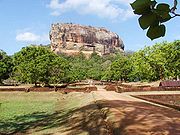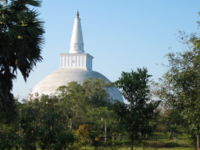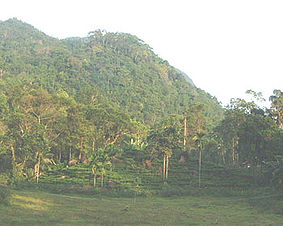
World Heritage Sites of Sri Lanka
Encyclopedia
Eight sites of Sri Lanka have been inscribed in the UNESCO World Heritage, namely, the ancient city of Polonnaruwa
(1982), the ancient city of Sigiriya
(1982), the Golden Temple of Dambulla
(1991), the old town of Galle
and its fortifications (1988), the sacred city of Anuradhapura
(1982), the sacred city of Kandy
(1988), Sinharaja Forest Reserve
(1988) and the Central Highlands of Sri Lanka
(2010).

The Sri Dalada Maligawa or The Temple of the Sacred Tooth Relic is a temple in the city of Kandy in Sri Lanka. It was built within the royal palace complex which houses the only surviving relic of Buddha, a tooth, which is venerated by Buddhists. The relic has played an important role in the local politics since ancient times, it's believed that whoever holds the relic holds the governance of the country, which caused the ancient kings to protect it with great effort. Kandy was the capital of the Sinhalese Kings from 1592 to 1815, fortified by the terrain of the mountains and the difficult approach. The city is a world heritage site declared by UNESCO, in part due to the temple.
Monks of the two chapters of Malwatte and Asgiriya conduct daily ritual worship in the inner chamber of the temple, in annual rotation. They conduct these services three times a day: at dawn, at noon and in the evening.
On Wednesdays there is a symbolic bathing of the Sacred Relic with an herbal preparation made from scented water and flagrant flowers, called Nanumura Mangallaya. This holy water is believed to contain healing powers and is distributed among those present.
The Temple has sustained damage from multiple bombings by terrorists in the past, but has been fully restored each time.

Sigiriya, considered by some as the eighth wonder of the world, consists of an ancient castle used by King Kasyapa of the 4th century AD. The Sigiriya site has the remains of an upper palace sited on the flat top of the rock, a mid-level terrace that includes the Lion Gate and the mirror wall with its frescoes, the lower palace that clings to the slopes below the rock, and the moats, walls and gardens that extend for some hundreds of metres out from the base of the rock.
The site is both a palace and fortress. Sufficient remains to provide the visitor with a stunning insight into the ingenuity and creativity of its builders.
The upper palace on the top of the rock includes cisterns cut into the rock that still retain water. The moats and walls that surround the lower palace are still exquisitely beautiful.

Anuradhapura, (අනුරාධපුර in Sinhala), is one of the ancient capitals of Sri Lanka, world famous for its well preserved ruins of the Great Sri Lankan Civilization. The Civilization which was built upon this city was one of the greatest civilizations of Asia and in the world. The city now a UNESCO heritage site, lies 205 km (127 mi) north of the current capital Colombo in the North Central Province of Sri Lanka, on the banks of the historic Malvathu Oya
. Founded in the 4th century BC it was the capital of the Anuradhapura Kingdom till the beginning of the 11th century AC. During this period it remained one of the most stable and durable centers of political power and urban life in South Asia. It was also a wealthy city which created a unique culture and a great civilization. Today this ancient city of Sri Lanka, which is sacred to the Buddhist world, which its surrounding monasteries covers an area of over sixteen square miles ( 40 km²) and is one of the world's major archaeological sites.

Galle (ˈɡɔːl, ˈɡaːlːə) is a town situated on the southwestern tip of Sri Lanka, 119 km (74 mi) from Colombo. Galle was known as Gimhathiththa (although Ibn Batuta in the 14th century refers to it as Qali) before the arrival of the Portuguese in the 16th century, when it was the main port on the island. Galle reached the height of its development in the 18th century, before the arrival of the British, who developed the harbor at Colombo.
On 26 December 2004 the city was devastated by the massive Boxing Day Tsunami caused by the 2004 Indian Ocean earthquake that occurred a thousand miles away, off the coast of Indonesia. Thousands were killed in the city alone.
However, with the exception of his immediate successor, Nissankamalla I, all other monarchs of Polonnaruwa, were slightly weak-willed and rather prone to picking fights within their own court. They also went on to form more intimiate matrimonial alliances with stronger South Indian Kingdoms, until these matrimonial links superseded the local royal lineage and gave rise to the Kalinga invasion by King Magha in 1214 and the eventual passing of power into the hands of a Pandyan King following the Arya Chakrawarthi invasion of Sri Lanka in 1284. The capital was then shifted to Dambadeniya.
Today the ancient city of Polonnaruwa remains one of the best planned Archeological relic sites in the country, standing testimony to the discipline and greatness of the Kingdom's first rulers.
The ancient city of Polonnaruwa has been declared a World Heritage site by UNESCO.

Sinharaja Forest Reserve is a national park in Sri Lanka. It is of international significance and has been designated a Biosphere Reserve and World Heritage Site by UNESCO.
The hilly virgin rainforest, part of the Sri Lanka lowland rain forests ecoregion, was saved from the worst of commercial logging by its inaccessibility, and was designated a World Biosphere Reserve in 1978 and a World Heritage Site in 1989. The reserve's name translates as Kingdom of the Lion.
The reserve is only 21 km (13 mi) from east to west, and a maximum of 7 km (4 mi) from north to south, but it is a treasure trove of endemic species, including trees, insects, amphibians, reptiles, birds and mammals.
Because of the dense vegetation, wildlife is not as easily seen as at dry-zone national parks such as Yala. There are no elephants, and the 15 or so leopards are rarely seen. The commonest larger mammal is the endemic Purple-faced Langur.
and the Knuckles Conservation Forest
.
Polonnaruwa
The second most ancient of Sri Lanka's kingdoms, was first declared the capital city by King Vijayabahu I, who defeated the Chola invaders in 1070 AD to reunite the country once more under a local leader.-History:While Vijayabahu's victory and shifting of Kingdoms to the more strategic Polonnaruwa...
(1982), the ancient city of Sigiriya
Sigiriya
Sigiriya is a large stone and ancient rock fortress and palace ruin in the central Matale District of Sri Lanka, surrounded by the remains of an extensive network of gardens, reservoirs, and other structures...
(1982), the Golden Temple of Dambulla
Dambulla cave temple
Dambulla cave temple also known as the Golden Temple of Dambulla is a World Heritage Site in Sri Lanka, situated in the central part of the country. This site is situated 148 km east of Colombo and 72 km north of Kandy...
(1991), the old town of Galle
Galle
Galle is a city situated on the southwestern tip of Sri Lanka, 119 km from Colombo. Galle is the capital city of Southern Province of Sri Lanka and it lies in Galle District....
and its fortifications (1988), the sacred city of Anuradhapura
Anuradhapura
Anuradhapura, , is one of the ancient capitals of Sri Lanka, famous for its well-preserved ruins of ancient Lankan civilization.The city, now a UNESCO World Heritage Site, lies 205 km north of the current capital Colombo in Sri Lanka's North Central Province, on the banks of the historic...
(1982), the sacred city of Kandy
Kandy
Kandy is a city in the center of Sri Lanka. It was the last capital of the ancient kings' era of Sri Lanka. The city lies in the midst of hills in the Kandy plateau, which crosses an area of tropical plantations, mainly tea. Kandy is one of the most scenic cities in Sri Lanka; it is both an...
(1988), Sinharaja Forest Reserve
Sinharaja Forest Reserve
Sinharaja Forest Reserve is a national park and a biodiversity hotspot in Sri Lanka. It is of international significance and has been designated a Biosphere Reserve and World Heritage Site by UNESCO....
(1988) and the Central Highlands of Sri Lanka
Central Highlands of Sri Lanka
Central Highlands of Sri Lanka is the newest World Heritage Site in Sri Lanka. On 31 July 2010, the World Heritage Committee holding its 34th session in Brasília inscribed Central Highlands of Sri Lanka and Papahānaumokuākea of Hawaii as new World Heritage Sites. The site comprises the Peak...
(2010).
Sri Dalada Maligawa

The Sri Dalada Maligawa or The Temple of the Sacred Tooth Relic is a temple in the city of Kandy in Sri Lanka. It was built within the royal palace complex which houses the only surviving relic of Buddha, a tooth, which is venerated by Buddhists. The relic has played an important role in the local politics since ancient times, it's believed that whoever holds the relic holds the governance of the country, which caused the ancient kings to protect it with great effort. Kandy was the capital of the Sinhalese Kings from 1592 to 1815, fortified by the terrain of the mountains and the difficult approach. The city is a world heritage site declared by UNESCO, in part due to the temple.
Monks of the two chapters of Malwatte and Asgiriya conduct daily ritual worship in the inner chamber of the temple, in annual rotation. They conduct these services three times a day: at dawn, at noon and in the evening.
On Wednesdays there is a symbolic bathing of the Sacred Relic with an herbal preparation made from scented water and flagrant flowers, called Nanumura Mangallaya. This holy water is believed to contain healing powers and is distributed among those present.
The Temple has sustained damage from multiple bombings by terrorists in the past, but has been fully restored each time.
Sigiriya

Sigiriya, considered by some as the eighth wonder of the world, consists of an ancient castle used by King Kasyapa of the 4th century AD. The Sigiriya site has the remains of an upper palace sited on the flat top of the rock, a mid-level terrace that includes the Lion Gate and the mirror wall with its frescoes, the lower palace that clings to the slopes below the rock, and the moats, walls and gardens that extend for some hundreds of metres out from the base of the rock.
The site is both a palace and fortress. Sufficient remains to provide the visitor with a stunning insight into the ingenuity and creativity of its builders.
The upper palace on the top of the rock includes cisterns cut into the rock that still retain water. The moats and walls that surround the lower palace are still exquisitely beautiful.
Anuradhapura

Anuradhapura, (අනුරාධපුර in Sinhala), is one of the ancient capitals of Sri Lanka, world famous for its well preserved ruins of the Great Sri Lankan Civilization. The Civilization which was built upon this city was one of the greatest civilizations of Asia and in the world. The city now a UNESCO heritage site, lies 205 km (127 mi) north of the current capital Colombo in the North Central Province of Sri Lanka, on the banks of the historic Malvathu Oya
Malvathu Oya
The Malvathu River is a long river in Sri Lanka, connecting the city of Anuradhapura, which was the capital of the country for over 15 centuries, to the coast of Mannar. It currently ranks as the second longest river in the country, with a great historic significance...
. Founded in the 4th century BC it was the capital of the Anuradhapura Kingdom till the beginning of the 11th century AC. During this period it remained one of the most stable and durable centers of political power and urban life in South Asia. It was also a wealthy city which created a unique culture and a great civilization. Today this ancient city of Sri Lanka, which is sacred to the Buddhist world, which its surrounding monasteries covers an area of over sixteen square miles ( 40 km²) and is one of the world's major archaeological sites.
Galle

Galle (ˈɡɔːl, ˈɡaːlːə) is a town situated on the southwestern tip of Sri Lanka, 119 km (74 mi) from Colombo. Galle was known as Gimhathiththa (although Ibn Batuta in the 14th century refers to it as Qali) before the arrival of the Portuguese in the 16th century, when it was the main port on the island. Galle reached the height of its development in the 18th century, before the arrival of the British, who developed the harbor at Colombo.
On 26 December 2004 the city was devastated by the massive Boxing Day Tsunami caused by the 2004 Indian Ocean earthquake that occurred a thousand miles away, off the coast of Indonesia. Thousands were killed in the city alone.
Polonnaruwa
The second most ancient of Sri Lanka's kingdoms, Polonnaruwa was first declared the capital city by King Vijayabahu I, who defeated the Chola invaders in 1070 CE to reunite the country once more under a local leader. While Vijayabahu's victory and shifting of Kingdoms to the more strategic Polonnaruwa is considered significant, the real Polonnaruwa Hero of the history books is actually his grandson, Parakramabahu I. The city Polonnaruwa was also called as Jananathamangalam during the short Chola reign.However, with the exception of his immediate successor, Nissankamalla I, all other monarchs of Polonnaruwa, were slightly weak-willed and rather prone to picking fights within their own court. They also went on to form more intimiate matrimonial alliances with stronger South Indian Kingdoms, until these matrimonial links superseded the local royal lineage and gave rise to the Kalinga invasion by King Magha in 1214 and the eventual passing of power into the hands of a Pandyan King following the Arya Chakrawarthi invasion of Sri Lanka in 1284. The capital was then shifted to Dambadeniya.
Today the ancient city of Polonnaruwa remains one of the best planned Archeological relic sites in the country, standing testimony to the discipline and greatness of the Kingdom's first rulers.
The ancient city of Polonnaruwa has been declared a World Heritage site by UNESCO.
Cave Temple Dambulla
Dambulla Cave Temple (also known as the Golden Temple of Dambulla) is a world heritage site (1991) in Sri Lanka, situated in the central part of the country. This site is situated 148 km (92 mi) east of Colombo and 72 km (45 mi) north of Kandy. It is the largest and best-preserved cave temple complex in Sri Lanka. The rock towers 160 m (525 ft) over the surrounding plains.There are more than 80 documented caves in the surrounding. Major attractions are spread over 5 caves, which contain statues and paintings. This paintings and statues are related to Lord Buddha and his life. There are total of 153 Buddha statues, 3 statues of Sri Lankan kings and 4 statues of gods and goddesses. The later 4 include two statues of Hindu gods, god Vishnu and god Ganesh. The murals, covers an area of 2,100 square meters. Depictions in the walls of the caves include Buddha's temptation by Mara (demon) and Buddha's first sermon.Sinharaja Forest Reserve

Sinharaja Forest Reserve is a national park in Sri Lanka. It is of international significance and has been designated a Biosphere Reserve and World Heritage Site by UNESCO.
The hilly virgin rainforest, part of the Sri Lanka lowland rain forests ecoregion, was saved from the worst of commercial logging by its inaccessibility, and was designated a World Biosphere Reserve in 1978 and a World Heritage Site in 1989. The reserve's name translates as Kingdom of the Lion.
The reserve is only 21 km (13 mi) from east to west, and a maximum of 7 km (4 mi) from north to south, but it is a treasure trove of endemic species, including trees, insects, amphibians, reptiles, birds and mammals.
Because of the dense vegetation, wildlife is not as easily seen as at dry-zone national parks such as Yala. There are no elephants, and the 15 or so leopards are rarely seen. The commonest larger mammal is the endemic Purple-faced Langur.
Central Highlands of Sri Lanka
This site comprises the Peak Wilderness Protected Area, the Horton Plains National ParkHorton Plains National Park
Horton Plains National Park is a protected area in the central highlands of Sri Lanka and is covered by montane grassland and cloud forest. This plateau at an altitude of is rich in biodiversity and many species found here are endemic to the region. This region was designated a national park in...
and the Knuckles Conservation Forest
Knuckles Mountain Range
The Knuckles Mountain Range lies in central Sri Lanka, north-east of the city of Kandy. The range takes its name from a series of recumbent folds and peaks in the west of the massif which resemble the knuckles of clenched fist when viewed from certain locations in the Kandy District...
.
External links
- List of UNESCO World Heritage Sites — Official website

